By Nathan G. Briggs
There are some key points to consider when designing a new beef cow barn, or when retrofitting an older barn to handle mature beef cows. Overcrowding is a concern when housing any animals in confinement. For beef cattle, there is a hierarchy, or a pecking order, which can reduce feed consumption in those cows that fall lower in the hierarchy. Cows lower in the hierarchy often include young, growing heifers that need additional nutrients. To maximize cow health and performance of all mature beef cows, it is important to ensure that they have adequate pen and bunk space.
Animal housing requirements, both pen size and linear bunk space, are published for all animals in the FASS Guidelines for Animal Care and Use (FASS, 2020) and are summarized below for breeding beef cattle.
Space Requirements
Breeding cattle space requirements differ depending on housing type, mature body weight, and feed management. When designing a lot or barn, maximize the space within a given range. A key to successful planning is anticipating business growth (ie. increasing the cow herd). Calculate animal pen and bunk space requirements and be sure to allow room for growth, without compromising cattle condition or performance. Table 1 outlines spacing requirements for bred heifers, mature cows, and bulls.
Table 1. Floor or ground area and feeder space recommendations for beef cattle
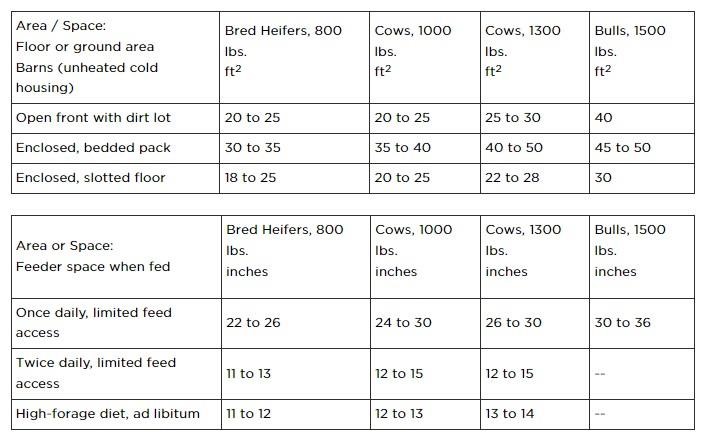
Click here to view Table 1 from PSU
The following example (Figure 1) was designed to further the understanding of designing a new barn: Imagine you want to house your 200 head cow herd (1,300 lbs./head) in an enclosed, unheated barn on a bedpack. Cattle would get limited access to feed twice daily on one long side of the barn. The bunk space required for a 1,300 lbs. cow being fed twice daily is 15 in/head. Thus, the total bunk space required for 200 cows is 250 ft (15 in/head x 200 head = 3,000 in / 12 in/ft = 250 ft). The bed pack space required for a cow at 1,300 lbs. is 50 ft2/head. In total, the barn would need to be 10,000 ft2 (50 ft2/head x 200 head = 10,000 ft2). Since cows are fed on one length of the barn, the width of the barn can be determined. The other side of the building should be 40 ft (10,000 ft2 / 250 ft = 40 ft).
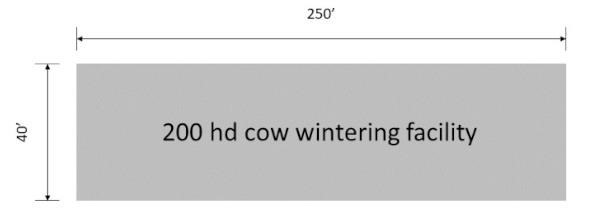
Alternatively, now imagine feeding the cows in the same scenario on both lengths of the barn. With the bunk space split between two sides, each side would need to be 125 ft (250 ft / 2 sides = 125/side). In this scenario, the width of the barn would be 80 ft (10,000 ft2 / 125 ft = 80 ft). Figure 2 depicts the dimensions for a barn feeding twice daily on two sides of the barn. Note: if you are unrolling and feeding free-choice hay to your cow herd, then these barn layouts would work for your operation as well. If you use 8-foot round bale feeders, approximately 10 feeders are needed to provide the bunk space needed.
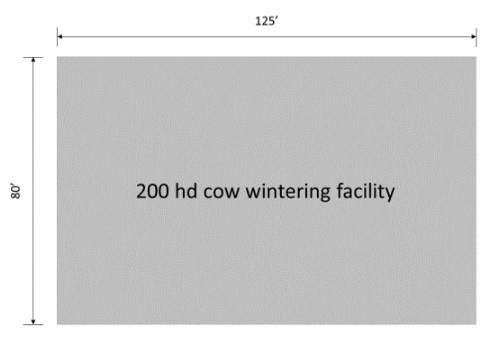
Barns that are being refurbished for cattle should have the stocking density determined based on pen size and linear bunk space available. In some older barn scenarios, bunk space is the first limitation to the number of animals that can be housed in a facility. Remember, shorting cattle of pen or bunk space can limit feed intake, thus, limiting cow performance. If you are considering placing cattle in existing facilities, consider the space requirements carefully.
Feeding Area
On the sides that cattle are fed, concrete flatwork is recommended to prevent feed waste. Make sure hay or feed is placed on a solid surface, such as a concrete surface or a feed bunk, to keep feed contained and prevent cattle from consuming debris, like stones. Keep the pen separated from the feed bunk. Concrete curbing between the pen and the feeding space can provide the separation needed to not waste feed resources.
There are many different methods to secure cattle in pens, yet allow cattle to eat from a feedbunk that is separated from the pen they reside in. One method is to incorporate a headlock or head gate that allows cattle to put their head through the gate, but this method can cause shoulder jostling and bruising when cattle eat at the feed bunk. Image 1 demonstrates cattle eating through neckslants. Another method is to use a neck rail that allows cattle to reach through to the feed bunk. A neck rail will prevent shoulder jostling and bruising because there are not vertical bars for cattle to press against. Images 2 through 4 shows different examples of a neck rails.
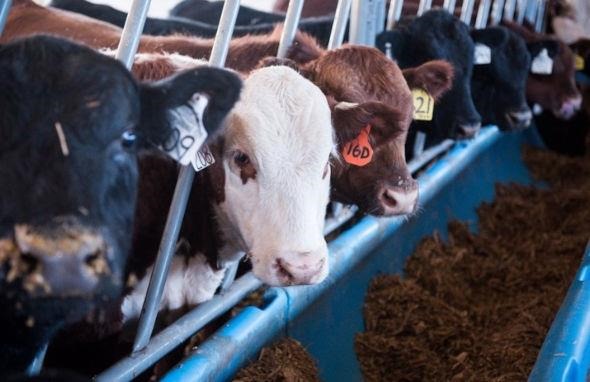
Crossbred beef cattle eating feed through neckslants. Courtesy of Dr. Tara Felix, Penn State.
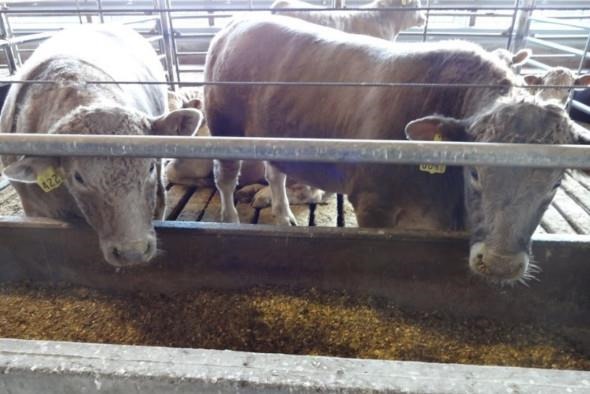
Charolais-based cattle eating feed through a cable and metal neck rail. Courtesy of Dr. Tara Felix, Penn State.
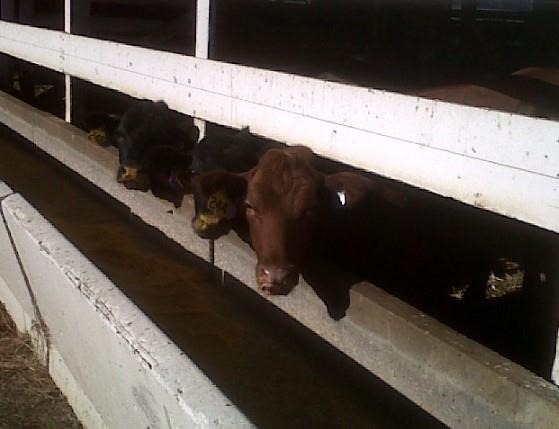
Crossbred cattle eating feed through a wooden neck rail. Courtesy of Dr. Tara Felix, Penn State.
Conclusion
Adequate pen and bunk space for breeding stock is extremely important for to maximize cow health, performance, and happiness. Based on cattle social order, less dominant animals could have restricted intake, resulting in declined health, performance, and happiness. If barns are overstocked, consider downsizing your herd or investing into larger facilities to handle the herd size. To have a successful operation that will last the test of time, ensure that cattle are placed in an area that allows for adequate pen and bunk space.
Source : psu.edu